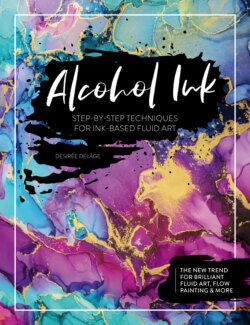Читать книгу Alcohol Ink - Desirée Delâge - Страница 9
ОглавлениеKey
Information
Modern painting with alcohol ink differs in many respects from well-known, traditional painting techniques. There are new painting surfaces, new tools, new effects and specific knowledge needed for working with alcohol ink. You’ll find this important basic knowledge on the following pages.
INKS
Alcohol inks usually consist of highly concentrated dye and therefore a little goes a long way. The colours available cover the entire spectrum, and are extremely intense. These inks are transparent to semi–transparent.
As well as the pure colours, there are also metallic inks, such as gold and silver. White alcohol ink is available too. Similar to the metallic colours, white is more opaque and has a slower flow than the coloured paints, which contain pigments. I’ll explain later how to apply these colours.
In addition to these basic inks, there are also various paint effects, such as ‘rainbow’ glitter ink!
The inks are either used neat or mixed with alcohol in small applicator bottles. Each bottle can contain just one colour or a mix of colours to create a new shade entirely. As a little ink goes a very long way, I recommend mixing your own right from the start. That way, you can prepare individual colours with your chosen intensity for a much more rewarding painting experience. I practise this regularly for different styles; sometimes you need diluted alcohol ink, sometimes it’s just right left neat.
The qualities of alcohol ink make it very special when compared to other painting media. One feature that is particularly important is that it can be re-dissolved with alcohol. This means that after you have created a design, the result can be further edited, decorated and designed. If something goes wrong, you can just wipe everything away with alcohol.
ISOPROPANOL
The alcohol that is used with these inks is called Isopropanol. This is high-percentage alcohol in concentrations of 90% or more. I mostly use 99.9% alcohol. You need to be very careful when working with these inks (see Precautions).
There is also a special alcohol-based paint medium for use with alcohol inks. Whether its use is relevant to you is down to your application purposes and requirements. For all the paintings and projects in this book, I have just used isopropanol.
SURFACES
To achieve the desired effects, the surface used for alcohol ink must not be absorbent. It’s best when your surface is smooth and water-repellent. You can use Yupo paper (a brand of synthetic paper), matt stone paper, film and any other material with the properties mentioned. You can also seal porous or rough surfaces and discover completely new possibilities. I will explain how to do this later.
TOOLS
For painting with alcohol ink, the equipment has less to do with paintbrushes, and much more to do with air. In the Materials & Equipment section, I explain in detail about using a hairdryer, hot-air blower, airbrush and all the other aids.
SEALING
Protecting your finished work is extremely important to shield it from ultraviolet (UV) light that could cause fading over time. Apply a layer of varnish to the work; in some cases, a layer to protect against scuffs and damage is also useful. You can do this by applying a coat of clear varnish or epoxy resin - this protects your work and also refines it. You will find a section on epoxy resin finishes later in this book.
"IF SOMETHING GOES WRONG, YOU CAN JUST WIPE EVERYTHING AWAY WITH ALCOHOL."
PRECAUTIONS
You should be aware that painting with alcohol ink is something that is only suitable for adults. The paints should only be used with protective measures in place, such as wearing gloves, opening a window (as a minimum), and preferably also wearing a breathing mask. The same caution applies here as for painting with varnishes. Under no circumstances does alcohol ink belong in children's hands. Even under supervision! Even the presence of children when you’re painting with alcohol ink is best avoided.
The reason for these precautions is that alcohol evaporates at much lower temperatures than water – even at room temperature, even when it’s liquid. Because of this quality, it means that when you paint with alcohol ink, there are always vapours around you. This isn’t bad in itself at low concentrations, but with alcohol ink, you usually paint wet on wet. The wet alcohol ink is blown with a hairdryer or airbrush, which speeds up the drying process, creating more vapour in the air. Also when you’re painting, you’re inevitably positioned above your work. Our body absorbs alcohol not only through our stomach, but also through our skin and mucous membranes in our noses, mouths and eyes. Alcohol vapours enter the blood and have similar effects to drinking alcohol. Of course, the effects depend on how long, how intensely and how often you paint with alcohol ink.
This explains why your workspace should at least be well ventilated, and why a mask that filters vapour, not just particles of dust, and gloves are essential. See more about the safety kit in the Equipment and Workspace section. It therefore follows that children should have nothing to do with painting with alcohol ink! Similarly, pregnant women should refrain from painting with it too.
Despite the requirements to take these precautions, there are thousands of enthusiastic alcohol ink painters. The small effort needed for your own protection is more than outweighed by the captivating painting experience and the ingenious results. Alcohol ink is a vibrant painting medium that always challenges and surprises creative people.
"YOUR WORKSPACE SHOULD BE WELL VENTILATED."
SAFETY TIPS:
Paint with the window open, as a minimum.
It’s best to paint outdoors.
Ideally wear a breathing mask.
Always wear gloves.
